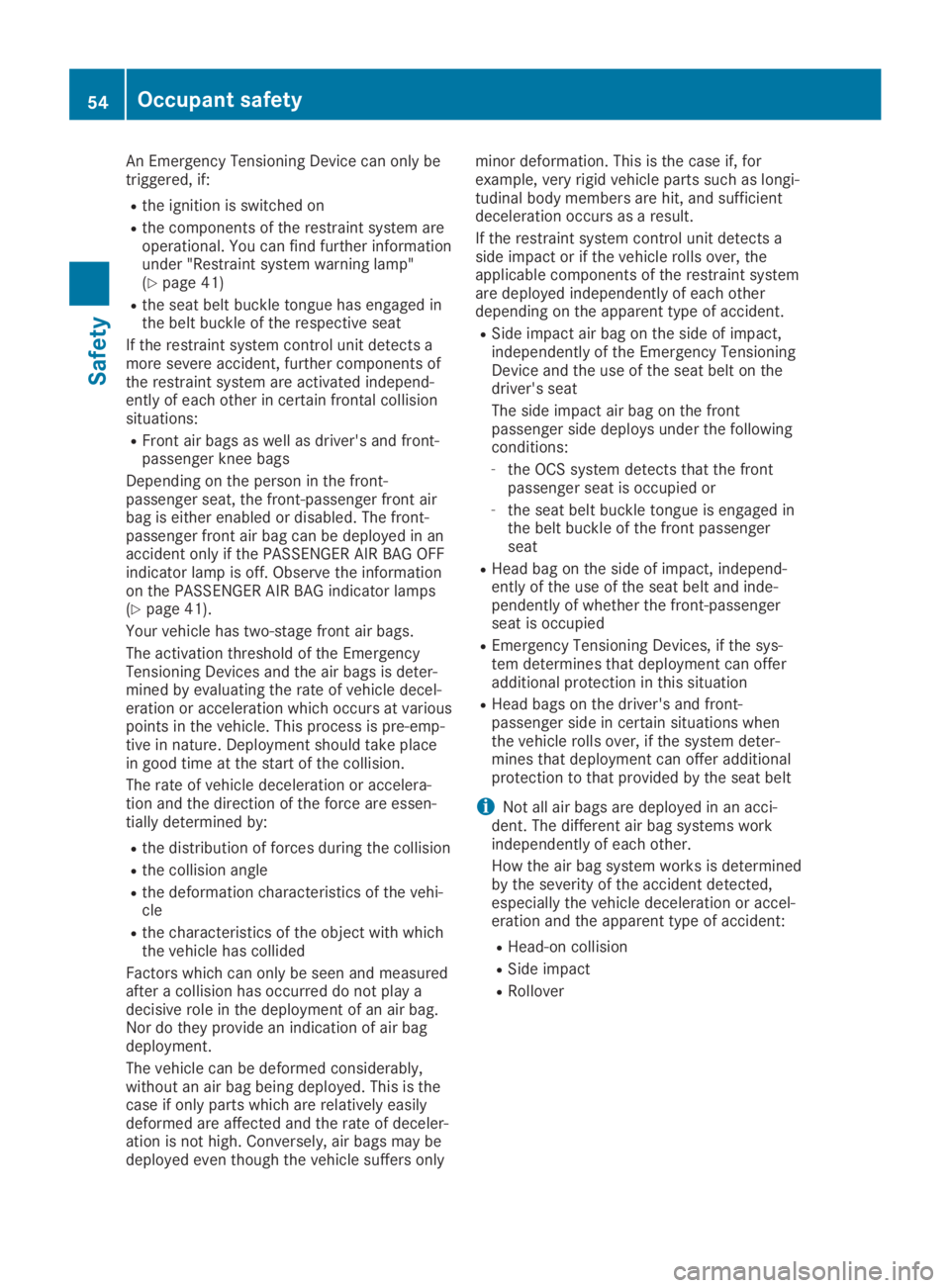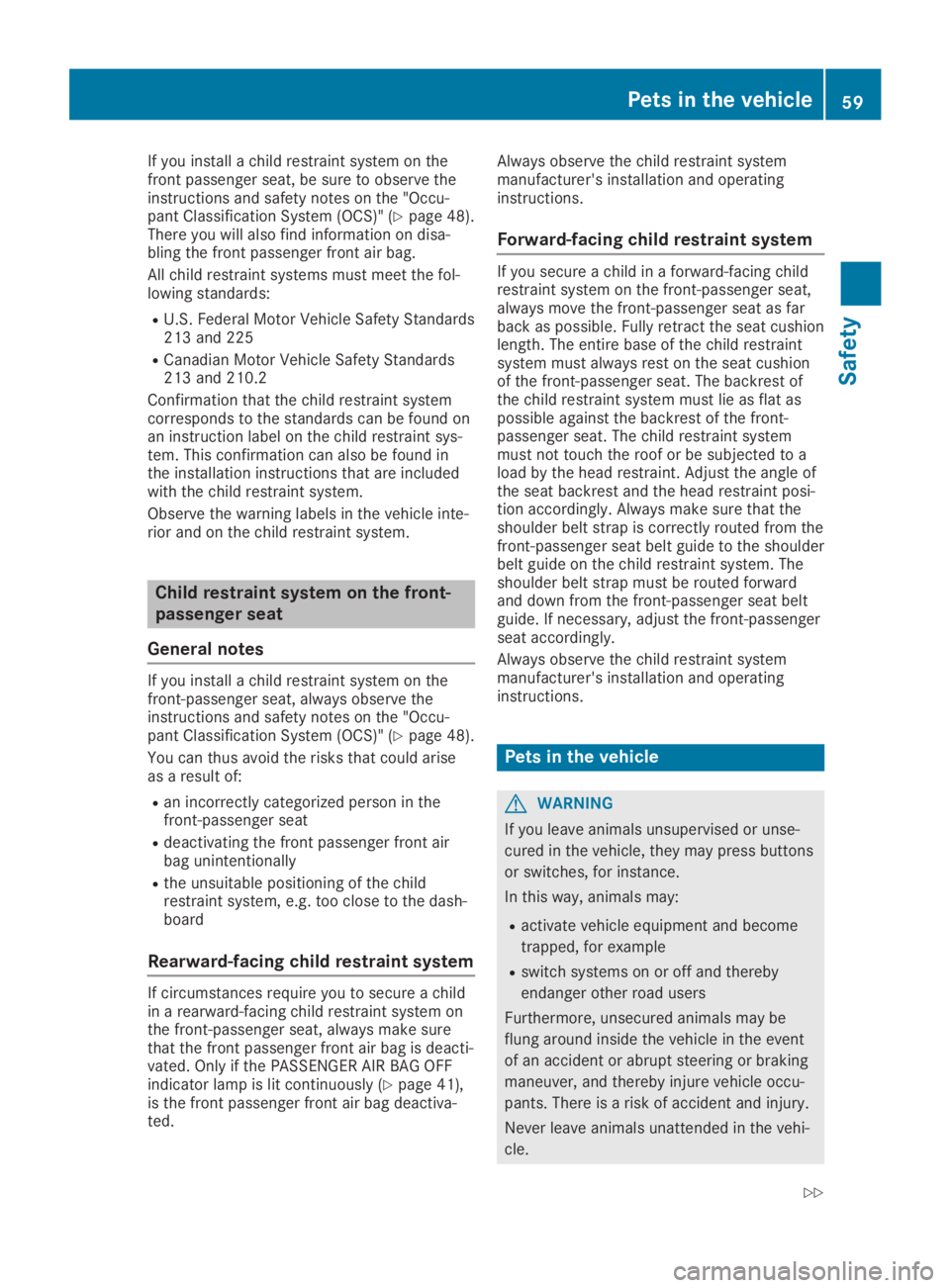2019 MERCEDES-BENZ SL CLASS airbag off
[x] Cancel search: airbag offPage 55 of 330

The roll bars are located in the rear area of thevehicle under the two outer rear compartmenttrim covers.
They extend if systems detect that the vehicleis in danger of rollover. The two outer rearcompartment trim covers are opened and theroll bars are extended within fractions of asecond.
Once the roll bars are extended, you can nolonger lower them. An open roof can no longerbe closed. In this case, visit the nearest quali-fied specialist workshop.
Deployment of Emergency Tension-
ing Devices and air bags
Important safety notes
GWARNING
The air bag parts are hot after an air bag has
been deployed. There is a risk of injury.
Do not touch the air bag parts. Have a
deployed air bag replaced at a qualified spe-
cialist workshop as soon as possible.
GWARNING
A deployed air bag no longer offers any pro-
tection and cannot provide the intended pro-
tection in an accident. There is an increased
risk of injury.
Have the vehicle towed to a qualified spe-
cialist workshop in order to have a deployed
air bag replaced.
For your own safety and that of your frontpassenger, it is important that you havedeployed air bags replaced and defective airbags repaired. This will help to make sure the
air bags continue to perform their protectivefunction for the vehicle occupants in the eventof a crash.
GWARNING
Emergency Tensioning Devices that have
deployed pyrotechnically are no longer
operational and are unable to perform their
intended protective function. This poses an
increased risk of injury or even fatal injury.
Have pyrotechnically triggered Emergency
Tensioning Devices replaced immediately at
a qualified specialist workshop.
An electric motor is used by PRE-SAFE®totrigger the tightening of the seat belt in haz-ardous situations. This procedure is reversible.
If Emergency Tensioning Devices are triggeredor air bags are deployed, you will hear a bang,and some powder may also be released. The�urestraint system warning lamp lights up.
Only in rare cases will the bang affect yourhearing. The powder that is released generallydoes not constitute a health hazard, but it maycause short-term breathing difficulties in peo-ple with asthma or other respiratory problems.Provided it is safe to do so, you should leavethe vehicle immediately or open the window inorder to prevent breathing difficulties.
Air bags and pyrotechnic Emergency Tension-ing Devices (ETDs) contain perchlorate mate-rial, which may require special handling andregard for the environment. National guide-lines must be observed during disposal. In Cal-ifornia, seewww.dtsc.ca.gov/HazardousWaste/Perchlorate/index.cfm.
Method of operation
During the first stage of a collision, therestraint system control unit evaluates impor-tant physical data relating to vehicle decelera-tion or acceleration, such as:
Rduration
Rdirection
Rintensity
Based on the evaluation of this data, therestraint system control unit triggers the Emer-gency Tensioning Devices during a head-on orrear-end collision.
Occupant safety53
Safety
Z
Page 56 of 330

An Emergency Tensioning Device can only betriggered, if:
Rthe ignition is switched on
Rthe components of the restraint system areoperational. You can find further informationunder "Restraint system warning lamp"(Ypage 41)
Rthe seat belt buckle tongue has engaged inthe belt buckle of the respective seat
If the restraint system control unit detects amore severe accident, further components ofthe restraint system are activated independ-ently of each other in certain frontal collisionsituations:
RFront air bags as well as driver's and front-passenger knee bags
Depending on the person in the front-passenger seat, the front-passenger front airbag is either enabled or disabled. The front-passenger front air bag can be deployed in anaccident only if the PASSENGER AIR BAG OFFindicator lamp is off. Observe the informationon the PASSENGER AIR BAG indicator lamps(Ypage 41).
Your vehicle has two-stage front air bags.
The activation threshold of the EmergencyTensioning Devices and the air bags is deter-mined by evaluating the rate of vehicle decel-eration or acceleration which occurs at variouspoints in the vehicle. This process is pre-emp-tive in nature. Deployment should take placein good time at the start of the collision.
The rate of vehicle deceleration or accelera-tion and the direction of the force are essen-tially determined by:
Rthe distribution of forces during the collision
Rthe collision angle
Rthe deformation characteristics of the vehi-cle
Rthe characteristics of the object with whichthe vehicle has collided
Factors which can only be seen and measuredafter a collision has occurred do not play adecisive role in the deployment of an air bag.Nor do they provide an indication of air bagdeployment.
The vehicle can be deformed considerably,without an air bag being deployed. This is thecase if only parts which are relatively easilydeformed are affected and the rate of deceler-ation is not high. Conversely, air bags may bedeployed even though the vehicle suffers only
minor deformation. This is the case if, forexample, very rigid vehicle parts such as longi-tudinal body members are hit, and sufficientdeceleration occurs as a result.
If the restraint system control unit detects aside impact or if the vehicle rolls over, theapplicable components of the restraint systemare deployed independently of each otherdepending on the apparent type of accident.
RSide impact air bag on the side of impact,independently of the Emergency TensioningDevice and the use of the seat belt on thedriver's seat
The side impact air bag on the frontpassenger side deploys under the followingconditions:
-the OCS system detects that the frontpassenger seat is occupied or
-the seat belt buckle tongue is engaged inthe belt buckle of the front passengerseat
RHead bag on the side of impact, independ-ently of the use of the seat belt and inde-pendently of whether the front-passengerseat is occupied
REmergency Tensioning Devices, if the sys-tem determines that deployment can offeradditional protection in this situation
RHead bags on the driver's and front-passenger side in certain situations whenthe vehicle rolls over, if the system deter-mines that deployment can offer additionalprotection to that provided by the seat belt
iNot all air bags are deployed in an acci-dent. The different air bag systems workindependently of each other.
How the air bag system works is determinedby the severity of the accident detected,especially the vehicle deceleration or accel-eration and the apparent type of accident:
RHead-on collision
RSide impact
RRollover
54Occupant safety
Safety
Page 61 of 330

If you install a child restraint system on thefront passenger seat, be sure to observe theinstructions and safety notes on the "Occu-pant Classification System (OCS)" (Ypage 48).There you will also find information on disa-bling the front passenger front air bag.
All child restraint systems must meet the fol-lowing standards:
RU.S. Federal Motor Vehicle Safety Standards213 and 225
RCanadian Motor Vehicle Safety Standards213 and 210.2
Confirmation that the child restraint systemcorresponds to the standards can be found onan instruction label on the child restraint sys-tem. This confirmation can also be found inthe installation instructions that are includedwith the child restraint system.
Observe the warning labels in the vehicle inte-rior and on the child restraint system.
Child restraint system on the front-
passenger seat
General notes
If you install a child restraint system on thefront-passenger seat, always observe theinstructions and safety notes on the "Occu-pant Classification System (OCS)" (Ypage 48).
You can thus avoid the risks that could ariseas a result of:
Ran incorrectly categorized person in thefront-passenger seat
Rdeactivating the front passenger front airbag unintentionally
Rthe unsuitable positioning of the childrestraint system, e.g. too close to the dash-board
Rearward-facing child restraint system
If circumstances require you to secure a childin a rearward-facing child restraint system onthe front-passenger seat, always make surethat the front passenger front air bag is deacti-vated. Only if the PASSENGER AIR BAG OFFindicator lamp is lit continuously (Ypage 41),is the front passenger front air bag deactiva-ted.
Always observe the child restraint systemmanufacturer's installation and operatinginstructions.
Forward-facing child restraint system
If you secure a child in a forward-facing childrestraint system on the front-passenger seat,always move the front-passenger seat as farback as possible. Fully retract the seat cushionlength. The entire base of the child restraintsystem must always rest on the seat cushionof the front-passenger seat. The backrest ofthe child restraint system must lie as flat aspossible against the backrest of the front-passenger seat. The child restraint systemmust not touch the roof or be subjected to aload by the head restraint. Adjust the angle ofthe seat backrest and the head restraint posi-tion accordingly. Always make sure that theshoulder belt strap is correctly routed from thefront-passenger seat belt guide to the shoulderbelt guide on the child restraint system. Theshoulder belt strap must be routed forwardand down from the front-passenger seat beltguide. If necessary, adjust the front-passengerseat accordingly.
Always observe the child restraint systemmanufacturer's installation and operatinginstructions.
Pets in the vehicle
GWARNING
If you leave animals unsupervised or unse-
cured in the vehicle, they may press buttons
or switches, for instance.
In this way, animals may:
Ractivate vehicle equipment and become
trapped, for example
Rswitch systems on or off and thereby
endanger other road users
Furthermore, unsecured animals may be
flung around inside the vehicle in the event
of an accident or abrupt steering or braking
maneuver, and thereby injure vehicle occu-
pants. There is a risk of accident and injury.
Never leave animals unattended in the vehi-
cle.
Pets in the vehicle59
Safety
Z